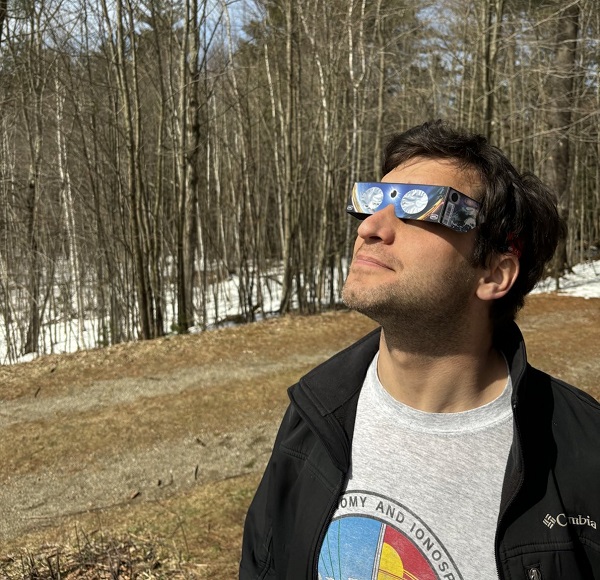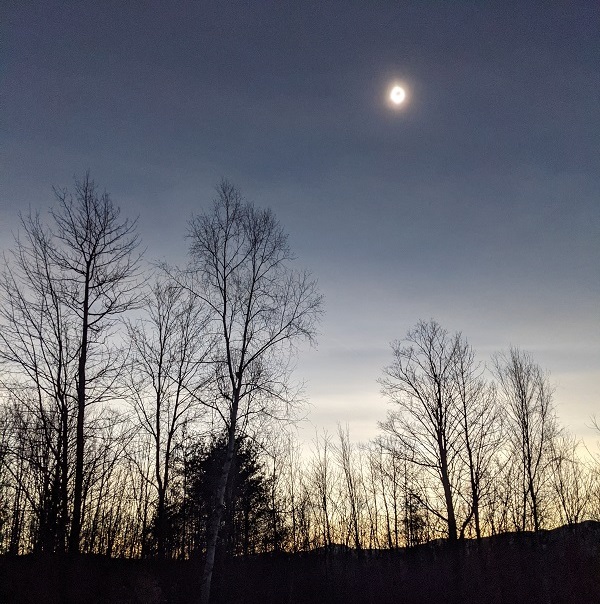[Previous: The eclipse of 2024: why are we lucky enough to have these on Earth?]
I missed the eclipse in 2017. The path of totality wasn’t that close to me, and I had an infant to care for, so traveling was out of the question.
This time was different.
The April 2024 solar eclipse was the last one that’d be visible from the U.S. for decades. Quite possibly, it was the only one that would be within driving distance of me for the rest of my life. I wasn’t going to miss it.
The weekend before, I set out on the long drive north. On the day of, I was camped out in a meadow with a crowd of other sightseers. There were families with kids, young people with dogs, photographers with solar lenses and camera mounts. The sky was clear blue and sunny, with only wisps of cloud. The mood was one of pleasant anticipation.
When the time arrived, the sun looked no different to the naked eye, too brilliant to glance at. But as the minutes crawled by, you could sense something happening. The light dimmed; colors faded. The warmth of a sunny April afternoon cooled into something more like fall.
Through eclipse glasses, the scene was completely different. You could see the dark disc of the moon moving across the face of the sun. It was an eerie sight, all the more so because it was invisible to the unaided eye.

Yes, I wore my Arecibo shirt
Over the course of an hour, that twilight dimming grew more noticeable, and the crowd’s anticipation increased. Through the filter of the glasses, the sun dwindled. It was a circle with a bite taken out, then a crescent, at last a slender arc.
And then, all at once – totality.
The sun dazzled, then dimmed, then darkened. The shadow of the moon, which had been there all along, suddenly emerged into view like an actor rising out of a trapdoor onto center stage.
Night fell in an instant, as swiftly as if a curtain had dropped over the world. The temperature plunged, and a chilly breeze kicked up. Venus emerged in a twinkle. A reddish sunset glow clung to the horizon.
Where the sun had been, there was a black void surrounded by a ghostly ring of fire, like a burning hole in the sky.
There was a collective gasp. A mass indrawn breath.

A goad to the imagination
Solar eclipses have been occurring for the entire span of humanity’s existence. I can only imagine what it felt like for ancient people to see this without knowing what it was. There must have been mass panic, weeping and prayer and frenzy, orgies of hedonism and outbreaks of violence. They probably thought the world was ending, and with good reason.
Even I, knowing it was harmless and that the sun would return momentarily, still felt a little frisson, a shiver at the back of my neck. It was impossible not to.
It was a sharp reminder that the sun doesn’t exist for us; it’s not a hanging lamp put there for our convenience. We live on a planet plunging through the dark, whirling among many other celestial bodies all following their own courses. It was tangible evidence of the vast universe out there, that has nothing to do with us.
In those ancient times, when an eclipse ended and the sun returned, there must have been a rush to interpret its meaning, a proliferation of prophets all offering dueling explanations. Many new religions must have been born, and perhaps some old religions died.
I once wrote that my humanism comes from the stars. After seeing an eclipse, I’ve come to believe that religions come from the stars as well. Not in the sense of UFOs and alien astronauts bringing revelations, but in the sense that people’s imaginations have always been fired by dramatic sights in the world around them.
It’s not just eclipses, but comets, meteor showers, planetary conjunctions, constellations: everything in the heavens that seemed strange, significant or noteworthy. We know that the movement of the skies was important for ancient people, to mark the seasons and predict the times for agriculture, if for no other reason.
But it was also a wellspring of creativity and a goad to the imagination. I wonder how much of our mythology originates from people who saw something unusual in the sky and spun a story about it. The ancient Greeks put gods and heroes there, and other civilizations did the same. It’s not a stretch to imagine that myths of more recent vintage about resurrected saviors and heavenly battles of angels and demons may have similar origins.
Knowledge deepens wonder
Back in the present, that sheer, vertical awe only lasted a moment. I said there was a collective gasp – but then people broke out into laughter, cheers and applause. It was an upwelling of ecstasy. Being there, standing beneath that unreal sky, was transcendent in the truest sense of the word.
The spectacular sight of totality was fleeting. In a few short minutes, the sun reemerged. Light flooded into the world. The sky lightened to blue, and the chill faded.
It was an experience I’ll never forget. And it inspired me in another way as well.
Where people once cowered from eclipses or treated them as portents of doom, now we know them for what they are, and we appreciate them more because of it. People came from hundreds of miles around specifically to see this one, because they wanted to be present for it. Some towns, like Burlington, Vermont, saw their population temporarily double. Our greater knowledge deepened our sense of wonder at the majesty of nature, rather than dispelling it.
The eclipse was no longer something to fear, no longer a sign of divine wrath. The crowds treated it as they should have – just an awe-inspiring natural phenomenon, courtesy of the laws of orbital mechanics and the grand clockwork of the cosmos. From fear to awe, from terror to wonder. That’s what science does.

The eclipse certainly put the wingnuts’ crazy into overdrive. Didn’t MTG insist that was a sign sent from the god she worships to repent? Fox News said Democrats planned the eclipse to spend the 5 minutes of darkness leading immigrants from the border–expecting their watchers to not comprehend something called “night”, which lasts hours every day.
Something about natural phenomena that struck you to momentary wonder, drives them to make up really stupid stories.
Yes!
Katydid @1:
LOL!
Seriously? Somebody actually said that? Out loud? (Why am I not surprised?)
@2, Bill Seymour; yes, they absolutely did! Democrats not only planned the eclipse in advance, but they also arranged it to cross the border, don’t ya know? I took a friend in for outpatient surgery and waited around in the waiting room all morning, and naturally the tv was tuned to Fox and normally that was all the talk in the room afterwards.
I only WISH Democrats had the power to manipulate an eclipse–with that sort of power, imagine what else they could do!
I live in western Oregon, but I saw only a little bit of a partial eclipse, only a little bite out of the Sun.
But I saw the 2017 one, and that was a great sight to see.
I prepared in advance by getting some eclipse glasses some weeks before, but then I saw warnings about how some of them were fakes. I decided that they might still be useful — if one does not look too long through them. Just like with looking at the Sun in general — it makes afterimages. I also punched holes in some paper plates so I could use them as pinhole cameras.
Earlier today, I put the glasses, some books, some paper, my digital camera, my cellphone, and some other stuff into a bag and took a folding chair with me to my house’s front yard.
The sky was clear, with only a few wispy clouds near the horizon, and the time was 9:10 am PDT. I was just in time to see the entering partial phase begin. I used the eclipse glasses, careful to look only briefly, but the Sun through them was dark orange. It looked like it had a small bite out of it at 1 o’clock.
I watched for about an hour as the entering phase continued, and the bit expanded and became noticeably circular.
By 10 am, it was still noticeably daylight, but not as bright, and the Sun looked like a crescent. Both with my eclipse glasses and with my paper-plate pinhole camera. The leaves of a nearby tree also made a nice pinhole-camera effect. The paper-plate pinhole image was not as relatively faint as it had early been, and I could easily see my cellphone’s display when I shade it. Earlier, shading it could make it only borderline visible.
I very briefly looked at the Sun around then, and while it was still bright, it did not make an afterimage.
By 10:14 am, my surroundings were noticeably dark, even with a daylight pattern of illumination, and the Sun was now a sliver at 7 o’clock.
I decided that it was safe to look at the Sun, and it looks like a bright spot on a ring — the diamond-ring effect. When the “diamond” faded, then at 10:17 am, …
TOTALITY. The Sun looked like a black disk with a thick white ring around it. The disk being the Moon and the ring being the corona. The sky looked as dark as dark twilight, even if not as dark as late night.
It lasted for a few minutes, and I got some pictures of it. Then I saw the diamond-ring effect again, and I knew that it was no longer safe to look directly at the Sun.
I stuck around for the remainder of the eclipse, the exiting partial phase, watching it as it happened. The Sun appeared on the opposite side of the Moon, at 1 o’clock, and as the eclipse ended at around 11:30 am, the Moon was at 7 o’clock. I then returned to my house with my bag and folding chair.